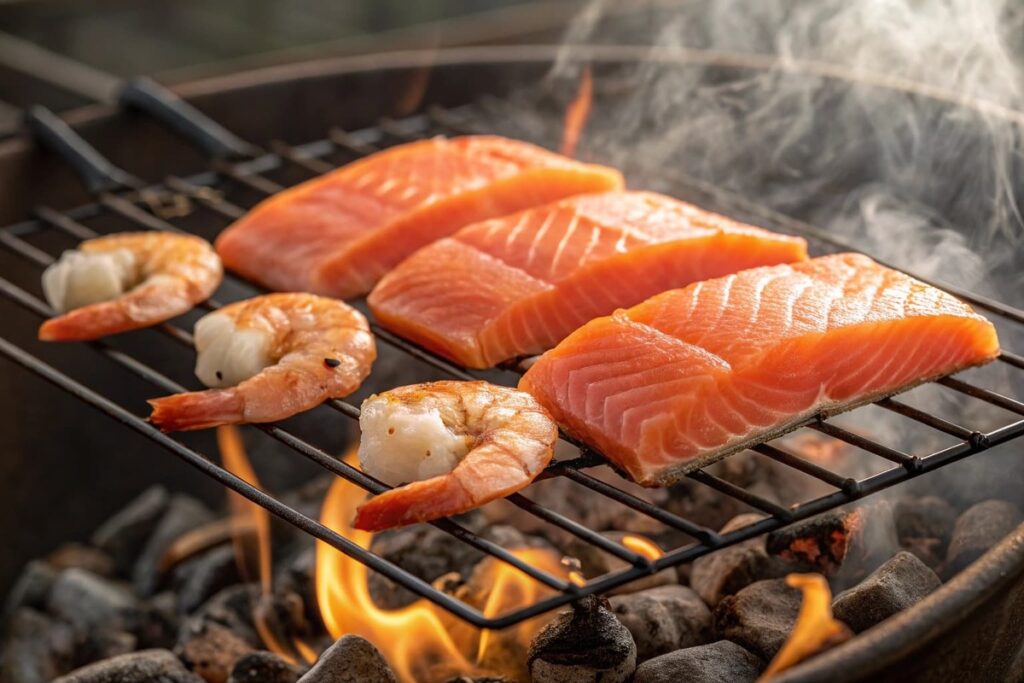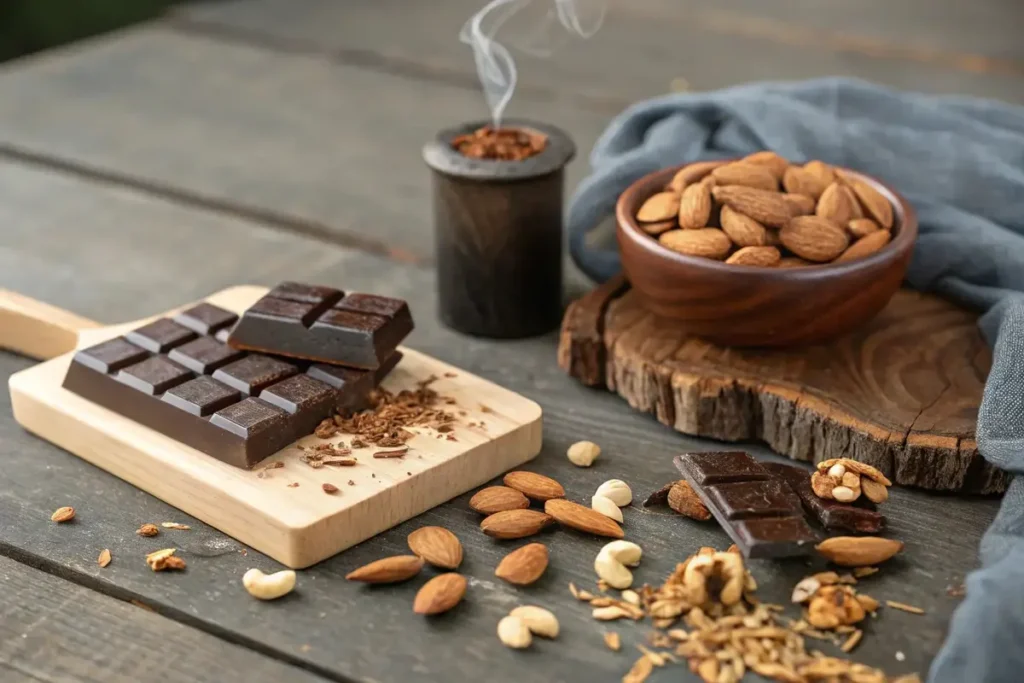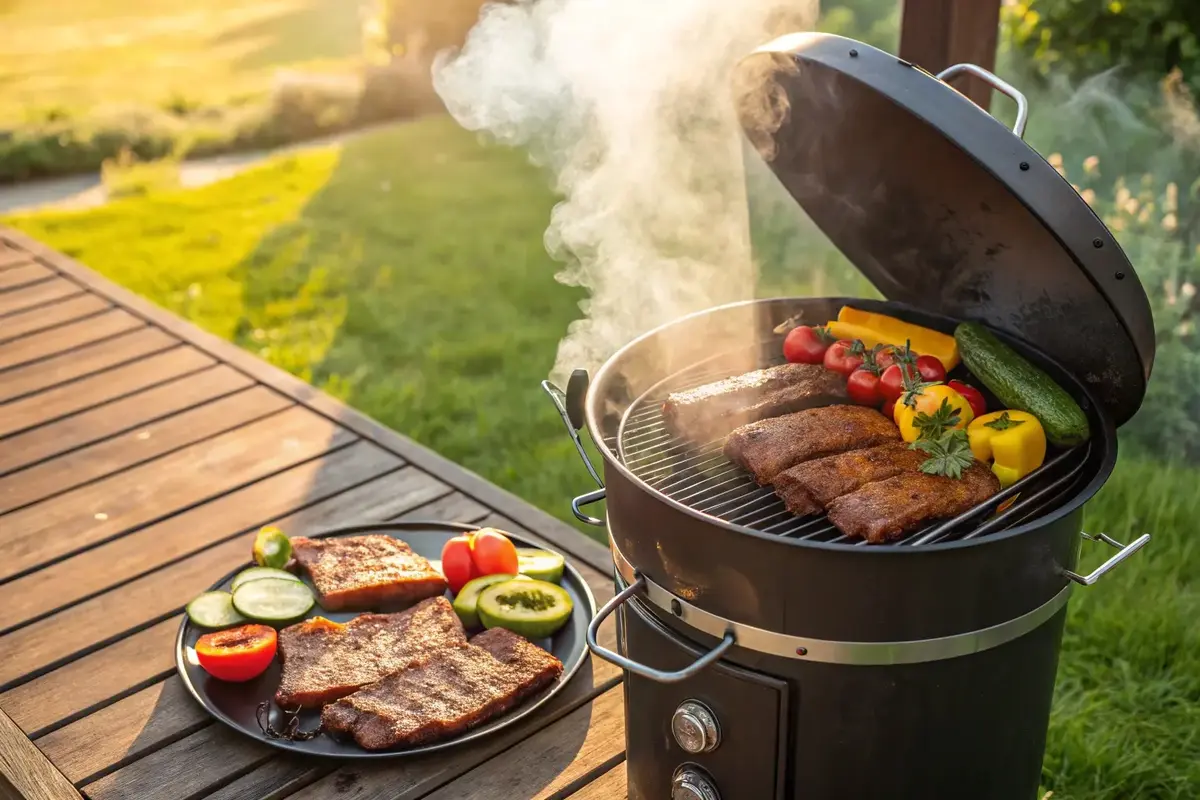Introduction
Smoking food is an art that combines technique, flavor, and patience to create culinary masterpieces. Whether you’re a fan of hearty meats, tender seafood, or creative plant-based dishes, smoking has something to offer everyone. This guide dives deep into discovering what is the best stuff to smoke in your smoker, from classic recipes to innovative ideas you might not have considered. Get ready to fire up your smoker and explore a world of rich, smoky flavors!
Part 1: Best Meats for Smoking
Beef Brisket
Brisket is often the first thing that comes to mind when you think about what is the best stuff to smoke. Known as the king of smoked meats, brisket is prized for its rich flavor and tender texture.
- Why It’s a Favorite: Brisket’s high-fat content ensures it stays juicy during long cooking times, while its ability to absorb smoke flavor makes it a standout dish.
- Tips for Smoking Brisket:
- Trim excess fat but leave a thin layer to protect the meat during cooking.
- Season with a bold dry rub and let it marinate overnight.
- Smoke at 225°F–250°F for 10–14 hours, using hickory or oak wood for robust flavor.
Pork Shoulder and Ribs
Pork is a smoker’s dream due to its marbling and ability to handle bold flavors.
- Pork Shoulder:
Perfect for pulled pork, the shoulder cut becomes melt-in-your-mouth tender when smoked low and slow. Smoke at 225°F for 12–16 hours with applewood or cherry wood. - Pork Ribs:
Ribs are a classic choice for smoker recipes. Remove the membrane, season generously, and smoke for 6 hours using the 3-2-1 method:- Smoke unwrapped for 3 hours.
- Wrap in foil with apple juice for 2 hours.
- Unwrap and finish with sauce for the last hour.
Chicken Thighs
For poultry lovers, chicken thighs are one of the easiest and most flavorful meats to smoke.
- Why Choose Thighs: Their higher fat content keeps them moist, even with extended smoking.
- How to Smoke Chicken Thighs: Brine the thighs for an hour, then season with your favorite spice blend. Smoke at 225°F for 2–3 hours with a mild wood like pecan or maple.
Lamb Ribs
If you’re looking to elevate your smoking repertoire, lamb ribs are a fantastic choice.
- Unique Taste: Lamb’s distinct flavor pairs beautifully with the smokiness, creating a rich and savory dish.
- Smoking Tips: Trim excess fat, season with garlic and rosemary, and smoke at 250°F for 3–4 hours with mesquite wood for a robust taste.
Part 3: Top Seafood Options for Smoking
Seafood takes on an entirely new dimension of flavor when smoked. Its delicate texture and natural oils make it perfect for absorbing the aromatic nuances of wood smoke. Here are some of the best seafood options for your smoker.
Salmon
- Ideal Smoking Conditions:
Salmon is a top choice for smoking due to its rich, fatty texture. For the best results, brine the fish in a mixture of water, salt, and brown sugar for 6–12 hours. Let it air-dry until a thin pellicle forms before placing it in the smoker.- Smoke at 160°F–180°F using alder or maple wood for 2–4 hours.
- Pair smoked salmon with crackers, cream cheese, or salads for a versatile and flavorful dish.
Trout
- Flavor Enhancement Through Smoking:
Like salmon, trout is an excellent candidate for smoking, but its smaller size means it cooks faster.- Season the trout with olive oil, salt, pepper, and fresh herbs.
- Smoke at 225°F for about 1–2 hours using applewood or cherry wood for a subtle, fruity flavor.
Smoked trout is perfect in sandwiches, spreads, or as a standalone appetizer.
Shrimp
- Quick Smoking Techniques:
Shrimp cooks quickly in a smoker, making it a great choice for appetizers or side dishes.- Marinate the shrimp in olive oil, garlic, and paprika for 30 minutes.
- Smoke at 225°F for 30–45 minutes using mild woods like alder or pecan.
Smoked shrimp can be served on skewers, tossed into pasta, or added to tacos for a smoky twist.
Oysters
- Smoking Methods for Shellfish:
Smoking oysters enhances their natural brininess while adding a rich, smoky depth.- Place cleaned oysters directly on the smoker rack.
- Smoke at 225°F for 30–40 minutes until the shells open.
- Finish with a drizzle of lemon or a dollop of herb butter.
Smoked oysters are a gourmet treat that works well as a starter or topping for crackers.
Part 4: Smoking Vegetables and Fruits
Smoking isn’t just for meats and seafood—vegetables and fruits can also benefit from the rich, smoky flavors your smoker provides. These options offer a unique twist on traditional recipes.
Bell Peppers
- How Smoking Intensifies Sweetness:
Smoking enhances the natural sweetness of bell peppers while adding a slight charred flavor.- Slice the peppers in half, remove the seeds, and coat them with olive oil.
- Smoke at 225°F for 45–60 minutes with applewood or cherry wood.
Smoked bell peppers can be used in salads, sandwiches, or as a base for stuffed pepper recipes.
Eggplant
- Achieving a Smoky, Creamy Texture:
Smoking transforms eggplant into a rich, creamy delight that works perfectly for dips and spreads.- Slice the eggplant lengthwise, brush with olive oil, and season with salt.
- Smoke at 225°F for 1–2 hours until soft and tender.
Smoked eggplant is ideal for making baba ganoush or as a smoky addition to vegetarian dishes.
Pineapple
- Combining Sweetness with Smokiness:
Pineapple’s natural sugars caramelize beautifully in a smoker, creating a sweet and smoky treat.- Slice the pineapple into rings or spears, and coat lightly with honey or brown sugar.
- Smoke at 225°F for 30–45 minutes using mild wood like maple or cherry.
Smoked pineapple is delicious on its own, in desserts, or as a topping for grilled meats.
Tomatoes
- Enhancing Sauces and Salsas with Smoked Tomatoes:
Smoking tomatoes intensifies their natural flavor, making them a perfect base for sauces and salsas.- Halve the tomatoes, remove the seeds, and drizzle with olive oil.
- Smoke at 225°F for 1–2 hours with a mild wood like alder or apple.
Smoked tomatoes can be blended into soups, pasta sauces, or dips for a smoky kick.

Part 5: Dairy and Nuts Suitable for Smoking
Smoking isn’t limited to savory meats and vegetables; dairy and nuts can also be transformed into gourmet delights with the right techniques.
Cheeses (e.g., Cheddar, Gouda)
Cold smoking is the best method for infusing cheeses with a subtle smoky flavor while maintaining their shape and texture.
- Cold Smoking Techniques:
- Choose semi-hard or hard cheeses like cheddar, gouda, or mozzarella for the best results.
- Set up your smoker for cold smoking, keeping the temperature below 90°F to prevent melting.
- Place the cheese blocks on the smoker rack and smoke for 2–4 hours using applewood or cherry wood for a mild, sweet flavor.
Smoked cheeses are perfect for charcuterie boards, sandwiches, or melting into recipes.
Almonds and Pecans
Smoking nuts enhances their natural oils and brings out a deep, roasted flavor, making them an ideal snack or addition to recipes.
- Creating Smoky Snacks:
- Toss almonds or pecans in olive oil and season with salt, garlic powder, or chili flakes for a savory touch.
- Spread the nuts evenly on a tray and smoke at 225°F for 1–2 hours using hickory or pecan wood.
- Stir occasionally to ensure even smoking.
These smoked nuts are great for snacking, topping salads, or adding to trail mixes.
Part 6: Unconventional Items to Smoke
Ready to think outside the box? These unconventional items prove that almost anything can be smoked to elevate its flavor.
Tofu
Tofu takes on smoky flavors exceptionally well, making it an excellent option for plant-based cooking.
- Infusing Flavor into Plant-Based Proteins:
- Press the tofu to remove excess water and marinate in soy sauce, garlic, and a touch of liquid smoke for added depth.
- Smoke at 225°F for 1–2 hours using mild woods like applewood or maple.
- Slice and serve in salads, sandwiches, or as a protein-packed snack.
Hard-Boiled Eggs
Give traditional hard-boiled eggs a smoky upgrade for a unique twist on a classic.
- Adding a Smoky Twist to Traditional Eggs:
- Boil and peel the eggs before placing them in the smoker.
- Smoke at 225°F for 30–60 minutes using pecan or cherry wood.
- Slice and use in salads, deviled eggs, or as a flavorful snack.
Chocolate
Smoked chocolate might sound unusual, but it’s a game-changer for desserts.
- Crafting Unique Desserts with Smoked Chocolate:
- Place chocolate bars or chips in a heat-safe dish and cold smoke them at a low temperature to avoid melting.
- Smoke for 1–2 hours using light woods like maple or cherry.
- Use the smoked chocolate in brownies, s’mores, or melted over fruits for a decadent treat.

Part 7: Essential Equipment for Smoking
Having the right equipment is crucial for achieving the best results when smoking food. Whether you’re a beginner or a seasoned enthusiast, investing in the proper tools can make all the difference.
Types of Smokers
Different smokers offer unique advantages depending on your needs and experience level.
Offset Smokers:
These traditional models feature a separate firebox, allowing indirect heat and smoke to flow into the cooking chamber. They’re great for large cuts of meat but require consistent monitoring.
Electric Smokers:
Easy to use, these rely on electricity to maintain a steady temperature, making them ideal for beginners.
Pellet Smokers:
Combining convenience and flavor, these smokers use wood pellets to create consistent smoke and heat. They’re versatile and require minimal effort.
Charcoal Smokers:
Known for their authentic smoky flavor, charcoal smokers require more attention but deliver exceptional results for purists.
Necessary Accessories
Accessories enhance your smoking experience and ensure precision and safety.
Thermometers:
A reliable thermometer helps you monitor both the internal temperature of the food and the smoker itself.
Wood Chips:
Choose high-quality wood chips that match the flavor profile you want to achieve.
Maintenance Tools:
Brushes, scrapers, and cleaning tools are essential for keeping your smoker in top condition, extending its lifespan.
With the right smoker and accessories, you’ll be well-equipped to tackle any recipe with confidence.
Part 8: Wood Selection and Flavor Profiles
The type of wood you choose significantly impacts the flavor of your smoked food. Selecting the right wood can elevate your dishes from good to unforgettable.
Hardwoods (e.g., Hickory, Mesquite)
Hardwoods are ideal for robust meats like beef and pork, providing bold and earthy flavors.
Hickory:
Hickory is one of the most popular smoking woods. It adds a strong, savory flavor, making it perfect for brisket, ribs, and pork shoulder.
Mesquite:
Mesquite is known for its intense, smoky flavor. It’s best used sparingly or combined with milder woods to avoid overpowering the food. Ideal for red meats and game.
Fruitwoods (e.g., Apple, Cherry)
Fruitwoods offer a mild, sweet flavor that complements more delicate items.
Apple:
Applewood adds a light, fruity flavor, making it perfect for chicken, pork, and even vegetables.
Cherry:
Cherry wood provides a subtle sweetness and a reddish tint to meats, making it a versatile choice for poultry, pork, and seafood.
Experimenting with different woods and combinations allows you to craft unique flavor profiles for your smoked dishes.
Part 9: Smoking Techniques and Tips
Mastering smoking techniques requires a balance of precision, patience, and practice. By focusing on temperature control, smoke management, and timing, you can ensure consistently delicious results.
Temperature Control
Maintaining consistent heat levels is one of the most critical aspects of successful smoking.
- Why It’s Important:
Fluctuating temperatures can lead to uneven cooking, drying out the food or undercooking it. - How to Achieve It:
- Use a reliable thermometer to monitor the smoker’s internal temperature.
- Adjust air vents to regulate airflow—more airflow increases heat, while less lowers it.
- Preheat the smoker and maintain a steady temperature based on the recipe (usually 225°F–275°F).
Consistent temperature control ensures your food is cooked evenly and retains its moisture.
Smoke Management
The quality of smoke you produce significantly impacts the flavor of your food.
- Ensuring Clean and Flavorful Smoke:
- Use seasoned or kiln-dried wood to avoid thick, acrid smoke caused by unseasoned wood.
- Look for thin, blue smoke, which indicates clean burning. Avoid thick, white smoke, which can impart a bitter taste.
- Add wood chips or chunks gradually rather than all at once to maintain balance.
By managing smoke effectively, you can create rich, complex flavors without overpowering the food.
Timing and Patience
Smoking is a slow process, and rushing it can ruin the final result.
- Importance of Cooking Durations:
- Smoking requires low-and-slow cooking to tenderize tough cuts of meat and allow flavors to develop fully.
- Use guidelines based on the food type: brisket may take up to 12 hours, while vegetables might only need 45 minutes.
- Let the food rest after smoking to allow the juices to redistribute, enhancing flavor and texture.
Patience is the key to unlocking the best results from your smoker.
Part 10: Health Considerations in Smoking
Smoking food can be both delicious and nutritious, but it’s essential to be mindful of its health implications. By understanding the benefits and potential risks, you can enjoy smoked foods safely.
Nutritional Aspects
Smoking can enhance the flavor of food while preserving nutrients, but there are some considerations.
- Benefits:
- Smoking is a natural preservative, reducing the need for artificial additives.
- Low-and-slow cooking retains moisture and nutrients better than high-heat methods.
- Smoked foods often require less added salt or sugar, making them healthier options.
- Risks:
- Over-smoking can create harmful compounds like polycyclic aromatic hydrocarbons (PAHs) and heterocyclic amines (HCAs).
- Consuming smoked foods in large quantities may contribute to long-term health concerns.
Reducing Harmful Compounds
You can minimize health risks by following best practices for safer smoking.
- Use clean, natural wood and avoid treated or resinous varieties.
- Maintain proper airflow to reduce the buildup of harmful smoke.
- Trim excess fat from meats to minimize dripping, which can cause flare-ups.
- Smoke at lower temperatures to reduce the formation of HCAs.
By smoking responsibly, you can enjoy the unique flavors and textures of smoked foods while prioritizing your health.
Part 11: Frequently Asked Questions (FAQs)
What is the easiest meat to smoke for beginners?
For beginners, pork shoulder and chicken thighs are excellent choices. These cuts are forgiving and remain juicy even if cooking times or temperatures fluctuate slightly. Pork shoulder is ideal for pulled pork, while chicken thighs cook relatively quickly and absorb smoke flavor beautifully.
Can I smoke multiple types of food at once?
Yes, you can smoke different foods simultaneously, but plan carefully. Foods with similar cooking times, like ribs and chicken, work well together. Use separate racks to avoid cross-contamination, and consider the strength of the smoke to ensure complementary flavors.
How long does it take to smoke vegetables compared to meat?
Vegetables typically require much less time than meats. Most vegetables are ready in 30–60 minutes, depending on their size and type, while meats like brisket can take 10–14 hours. Always check for tenderness in vegetables and use a meat thermometer for precise doneness in meats.
What wood is best for smoking seafood?
Mild woods like alder, apple, or cherry are ideal for seafood. These woods add subtle, sweet smoke flavors that enhance the delicate taste of fish and shellfish without overwhelming them.
Can desserts really be smoked without overpowering sweetness?
Absolutely! The key is to use light smoke and mild woods such as maple or fruitwoods. For example, smoked chocolate or cheesecake absorbs just enough smokiness to create a unique and balanced flavor without overpowering the dessert’s sweetness.
Are there any foods that shouldn’t be smoked?
Some foods don’t work well in a smoker. Leafy greens like spinach wilt too quickly, and delicate herbs may burn rather than absorb flavor. Avoid highly processed foods, as they don’t benefit much from smoking and may produce undesirable results.
Part 12: Conclusion
Embracing the Art of Smoking
Smoking food is more than a cooking method; it’s a journey of flavor, patience, and creativity. From meats and seafood to vegetables and even desserts, this guide has explored what is the best stuff to smoke and how to make the most of your smoker.
The versatility of smoking allows you to experiment and discover unique recipes tailored to your tastes. Whether you’re a novice or a seasoned enthusiast, there’s always something new to try.
So fire up your smoker, select your ingredients, and enjoy the rich, smoky flavors that only this technique can provide. Happy smoking!

